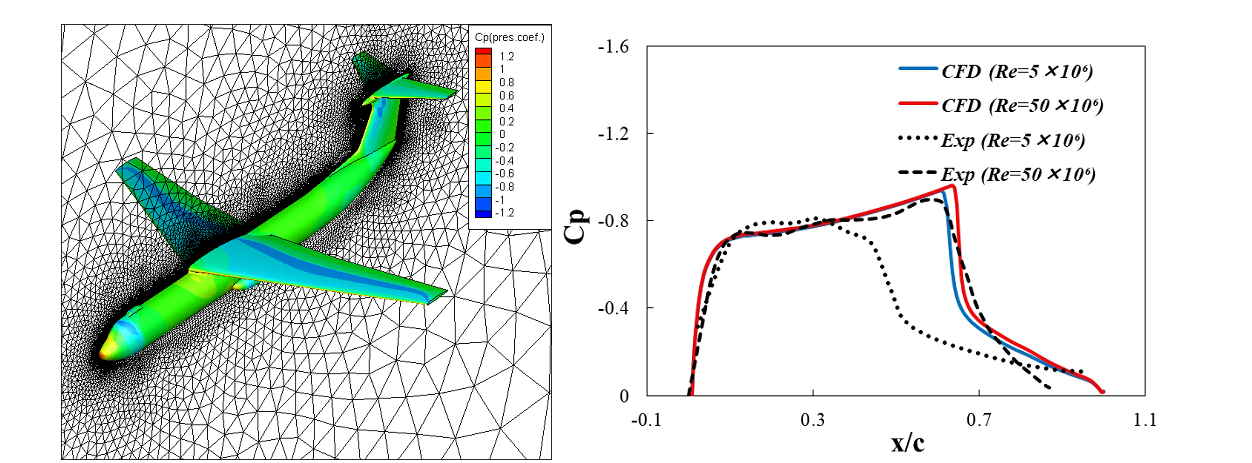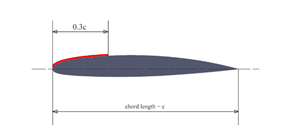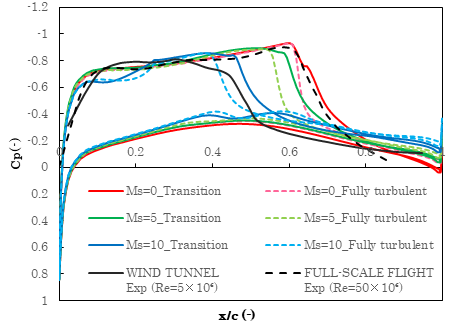Investigation of Indirect Reynolds Number Effect
JAXA Supercomputer System Annual Report April 2020-March 2021
Report Number: R20EDA201N08
Subject Category: Aeronautical Technology
- Responsible Representative: Takashi Aoyama, Director, Numerical Simulation Research Unit, Aeronautical Technology Directorate
- Contact Information: Makoto Ueno, Numerical Simulation Research Unit, Aeronautical Technology Directorate (ueno.makoto@jaxa.jp)
- Members: Wataru Yamazaki, Hiroki Ichihashi, Makoto Ueno
Abstract
We investigated and examined measures to improve the method of reproducing the loss considered to be equivalent to the tripping roughness of forced transition of the boundary layer of the wind tunnel test model in the transonic flow field of computational fluid dynamics (CFD) simulation. The effect of the loss on the indirect Reynolds number effect from the effect of the shock wave is clarified by the CFD simulation to which is applied.
Reference URL
N/A
Reasons and benefits of using JAXA Supercomputer System
It is necessary to perform CFD computation including flow around a whole aircraft because it requires highly parallelized computation. Additionally, the JSS2 was chosen because the FaSTAR CFD solver is optimized, as well.
Achievements of the Year
In this study, we conducted a study by computational fluid dynamics with the aim of clarifying the causes and physical factors of the indirect Reynolds number effect (significant advance of the shock wave position), which became a major problem in the C-141 aircraft design. By focusing on the effect of roughness used in the wind tunnel test and using a method that affects the source term of the Navier-Stokes equation, the effect of roughness is simulated while suppressing the calculation cost, and what kind of impact wave position is on the upper surface of the wing.
The influence was examined in the two-dimensional wing analysis and three-dimensional wing fuselage model analysis of C-141.
For the region of influence of the source term, in addition to the method of influencing the location of roughness, which is easy to understand as a model, the results of the wing surface Cp distribution qualitatively better match the experimental data of the wing leading edge boundary layer. We examined methods that affect a wide range.

Fig.1: C-141 CFD model (left: appearance, right: 38.9% wing cross section upper surface pressure coefficient distribution withoug the source term).
Publications
- Non peer-reviewed papers
Hiroki ICHIHASHI, Wataru YAMAZAKI and Makoto UENO, Investigation of indirect Reynolds number effect around airplane considering influence of roughness, 38th aerospace numerical simulation technology symposium, 2020.
Usage of JSS
Computational Information
- Process Parallelization Methods: MPI
- Thread Parallelization Methods: N/A
- Number of Processes: 216
- Elapsed Time per Case: 10 Hour(s)
Resources Used(JSS2)
Fraction of Usage in Total Resources*1(%): 0.04
Details
Please refer to System Configuration of JSS2 for the system configuration and major specifications of JSS2.
| System Name | Amount of Core Time(core x hours) | Fraction of Usage*2(%) |
|---|---|---|
| SORA-MA | 31.85 | 0.00 |
| SORA-PP | 73,979.51 | 0.58 |
| SORA-LM | 0.00 | 0.00 |
| SORA-TPP | 0.00 | 0.00 |
| File System Name | Storage Assigned(GiB) | Fraction of Usage*2(%) |
|---|---|---|
| /home | 19.07 | 0.02 |
| /data | 1,907.35 | 0.04 |
| /ltmp | 1,953.13 | 0.17 |
| Archiver Name | Storage Used(TiB) | Fraction of Usage*2(%) |
|---|---|---|
| J-SPACE | 0.00 | 0.00 |
*1: Fraction of Usage in Total Resources: Weighted average of three resource types (Computing, File System, and Archiver).
*2: Fraction of Usage:Percentage of usage relative to each resource used in one year.
Resources Used(JSS3)
Fraction of Usage in Total Resources*1(%): 0.00
Details
Please refer to System Configuration of JSS3 for the system configuration and major specifications of JSS3.
| System Name | Amount of Core Time(core x hours) | Fraction of Usage*2(%) |
|---|---|---|
| TOKI-SORA | 0.00 | 0.00 |
| TOKI-RURI | 0.00 | 0.00 |
| TOKI-TRURI | 0.00 | 0.00 |
| File System Name | Storage Assigned(GiB) | Fraction of Usage*2(%) |
|---|---|---|
| /home | 9.54 | 0.01 |
| /data | 95.37 | 0.00 |
| /ssd | 95.37 | 0.05 |
| Archiver Name | Storage Used(TiB) | Fraction of Usage*2(%) |
|---|---|---|
| J-SPACE | 0.00 | 0.00 |
*1: Fraction of Usage in Total Resources: Weighted average of three resource types (Computing, File System, and Archiver).
*2: Fraction of Usage:Percentage of usage relative to each resource used in one year.
JAXA Supercomputer System Annual Report April 2020-March 2021




